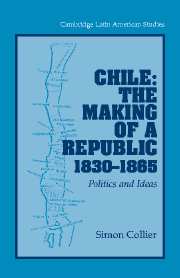Introduction
Published online by Cambridge University Press: 24 July 2009
Summary
It is a textbook commonplace that the Republic of Chile was a byword for political stability in nineteenth-century Latin America. Commonplaces are usually at least half true, and often more than half. Chile was the only Spanish American republic to win this reputation in the eyes of the outside world. The only other Latin American country to enjoy similar esteem was the Empire of Brazil, which almost until the end was a slaveholding society. (Slavery in Chile was abolished five years after independence.) Chile's transition to stability, however, was more eventful than the textbook commonplace assumes, with political life in what we may call “the early republic” marked by serious conflict as well as a promising degree of institutional continuity. The Chilean political tradition was forged in sharp and occasionally bloody struggles between government and its Liberal (and later Liberal-Conservative) adversaries. Not until the early 1860s were order (the key ideal of the Conservative governments) and greater political liberty (the principal demand of successive oppositions) reconciled to the satisfaction of most politicians. The ideas and politics of this formative period are the subject of this book.
The most perceptive review of my earlier book on the ideas and politics of Chile's independence period, by French historian Jean Meyer, hinted that my approach to the history of ideas rested on “une conception ‘hégélienne de droite.’” The label is not congenial, but he had a point.
- Type
- Chapter
- Information
- Chile: The Making of a Republic, 1830–1865Politics and Ideas, pp. xv - xxiiPublisher: Cambridge University PressPrint publication year: 2003

